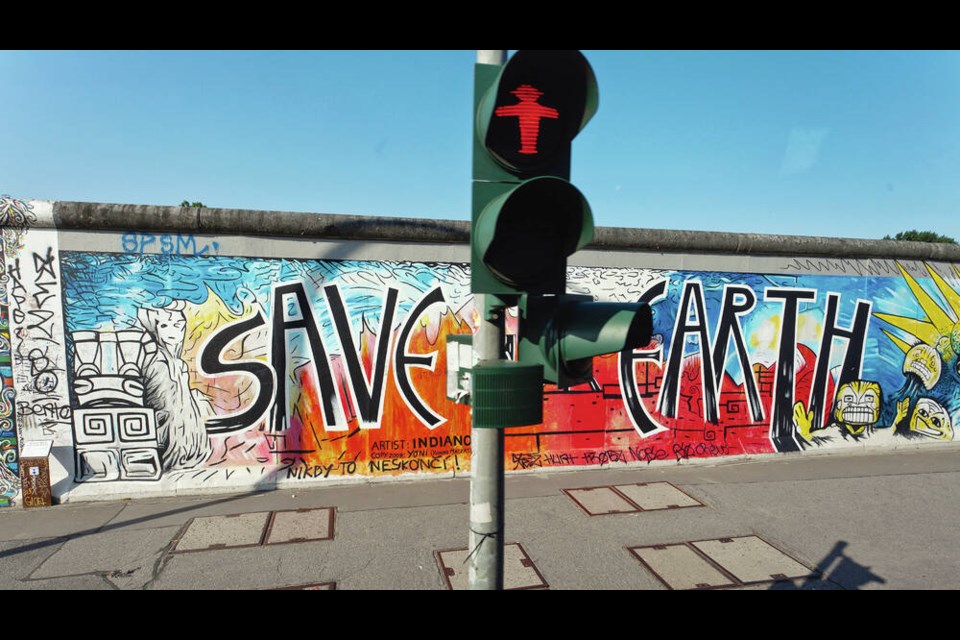Whenever I visit Berlin I can’t help remembering my spooky visit to East Berlin back in 1971. I vividly recall how, as we were about to return to West Berlin, our tour bus was stopped and emptied at a border crossing so mirrors could be rolled under the bus.
The guards wanted to see if anyone was trying to hitch a ride to freedom with us. (For a 16-year-old who was caught up in the anxiety of the Cold War, that left quite an impression.)
For nearly 30 years, the Berlin Wall divided Germany’s biggest city in two, just as a heavily fortified fence cut all of East Germany off from the West. Within Berlin, the border consisted of a low-profile inner wall and a 12-foot-high concrete outer wall topped with barbed wire and a rounded, pipe-like surface to discourage grappling hooks. Sandwiched between was a no-man’s-land (“death strip”) between 10 and 50 yards wide, patrolled by sentry towers spaced along the length of the wall.
It was built to encircle West Berlin, a 185-square-mile island of capitalism — the three sectors of the city occupied by the forces of the U.S., U.K., and France after the Second World War — surrounded by Soviet-controlled East Germany (a.k.a. the DDR). Between establishment of the DDR in 1949 and 1961, more than three million East Germans emigrated (fled) to freedom, many of them via Berlin.
To stanch their population loss, the DDR erected the 96-mile-long “Anti-Fascist Protective Rampart” around West Berlin almost overnight, beginning on August 13, 1961.
Of course, the wall soon became an emblem of the cruel injustices imposed on all Europeans behind the Iron Curtain. The world rejoiced at the sight of happy Berliners standing atop the wall on the night of November 9, 1989, when Easterners were first allowed through it — a sure sign that the once-mighty Soviet empire was crumbling from within. That very night, as celebrants passed beers to their long-lost cousins on the other side and adorned the famously Wall-adjacent Brandenburg Gate with flowers like a parade float, bystanders with hammers began chipping away at the concrete symbol of oppression.
Today, after decades of being nearly devoured by persistent “Wall-peckers,” little remains of the grandest souvenir of Cold War Berlin. Its former path is now marked by a subtle double row of cobbles in the streets, running even through some modern buildings.
The lengthiest stretch still standing is the East Side Gallery, near the Ostbahnhof train station. Murals by international artists cover nearly a mile of the concrete panels. (The artwork is routinely whitewashed so new works can be painted.)
Right in the middle of town, near the Topography of Terror exhibit, is a shorter section at Niederkirchnerstrasse/Wilhelmstrasse.
But the best place to take in a long stretch of the surviving Wall, and to learn about its history, is the Berlin Wall Memorial. Exhibits line up along four blocks of Bernauer Strasse, stretching northeast from the Nordbahnhof S-Bahn station with various open-air info points and memorials, several fragments of still-standing Wall, and two museums offering an insightful and well-presented history of the Wall and its impact on Berliners’ lives. From one of them, you can access an observation tower to peer down into a complete stretch of the “Wall system” (with both sides of its Wall and death strip all preserved intact).
Of the eight spots where Westerners could legally enter East Berlin for a temporary visit, perhaps the most poignant is an unassuming bureaucratic structure once attached to the Friedrichstrasse train station, which was situated within East Berlin but accessible by train from West Berlin.
This is where visiting West Berliners would take leave of their East German loved ones before crossing back into the free world. The scene of many sad farewells, the building earned the nickname “Tränenpalast” (Palace of Tears). It has since been converted into a museum about everyday life in a divided Germany, offering a fascinating peek into the paranoid border-control world of the DDR.
Most tourists, however, flock to Checkpoint Charlie, the most famous crossing point. A mockup of its document-checking guard house, which stands in its place today, gives a sense of what it was like to stand at this flashpoint in the Cold War. Here, U.S. and East German soldiers could stare each other down, separated by only a few dozen yards of barbed wire.
The nearby Museum of the Wall at Checkpoint Charlie focuses on the many brave and ingenious escape attempts over, under, and through the border into West Germany. (Berlin alone saw more than 5,000 documented successful escapes — 565 by East German guards — but also more than 140 deaths. Outside Berlin, roughly 1,000 people were killed trying to cross into West Germany.)
This museum is nowhere as well-presented or thoughtful as the Berlin Wall Memorial, but is itself a piece of Cold War history. Throughout the wall’s nearly three decades, this exhibit stood here defiantly — within spitting distance of the border guards — showing the whole world the tragedy of a divided people.
This article is used with the permission of Rick Steves’ Europe (www.ricksteves.com). Rick Steves writes European guidebooks, hosts travel shows on public TV and radio, and organizes European tours.



